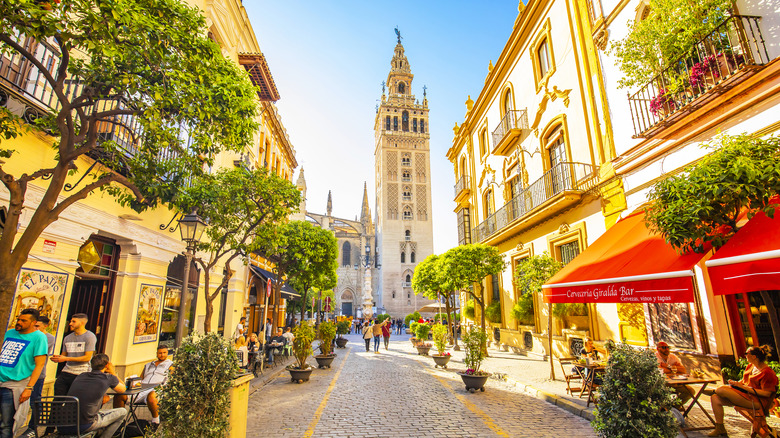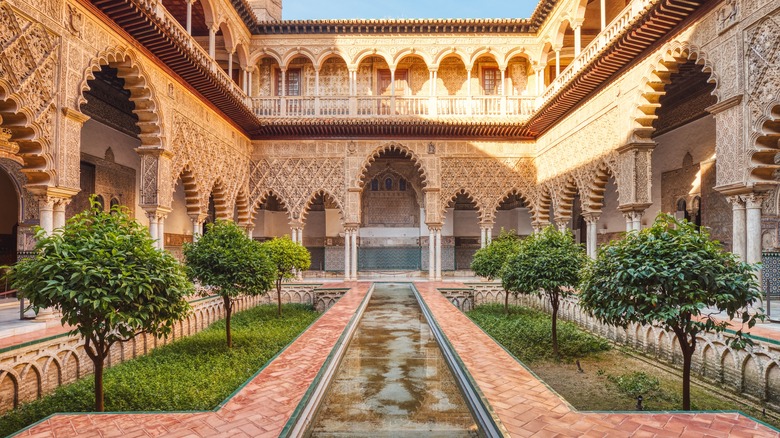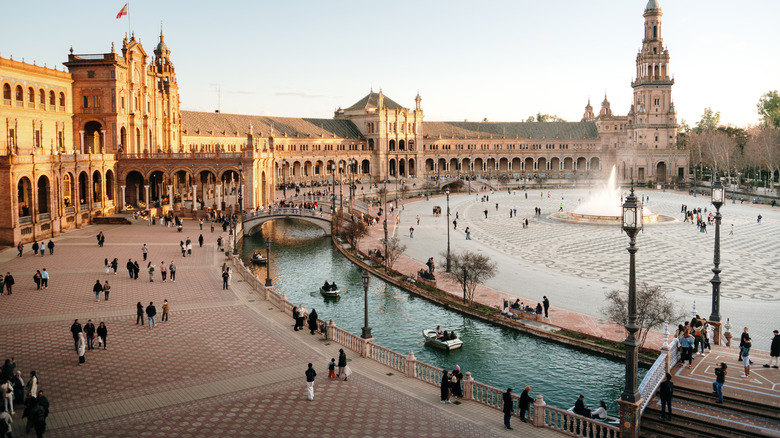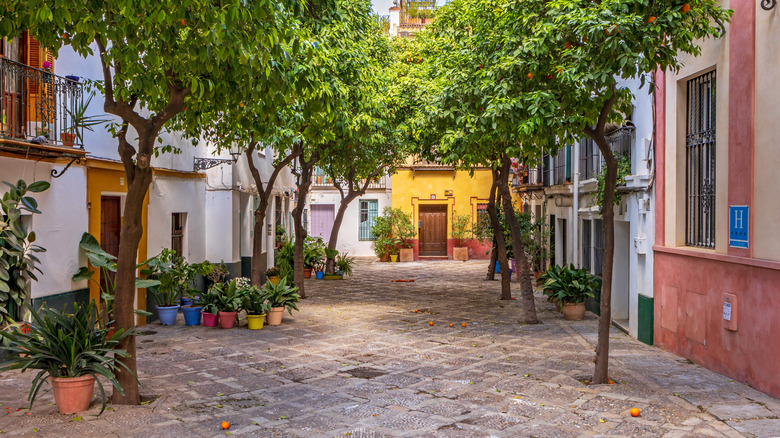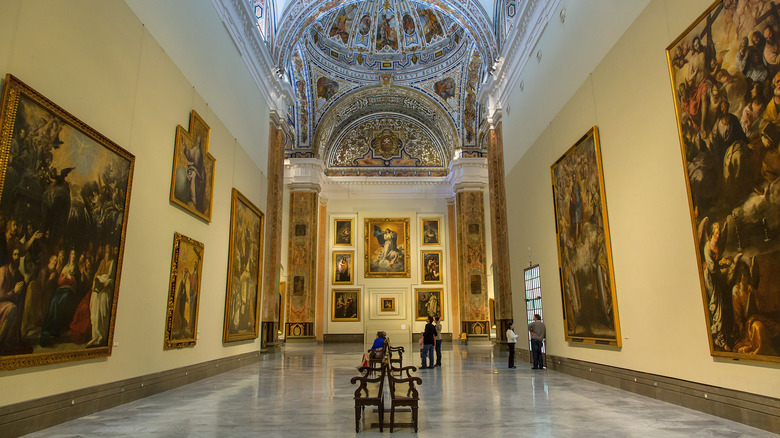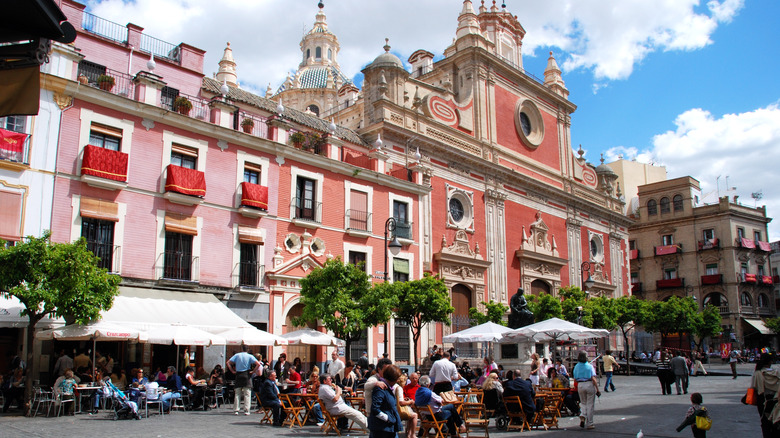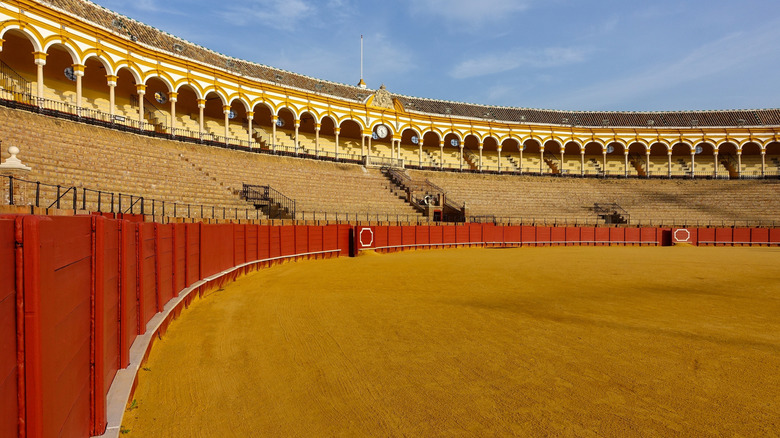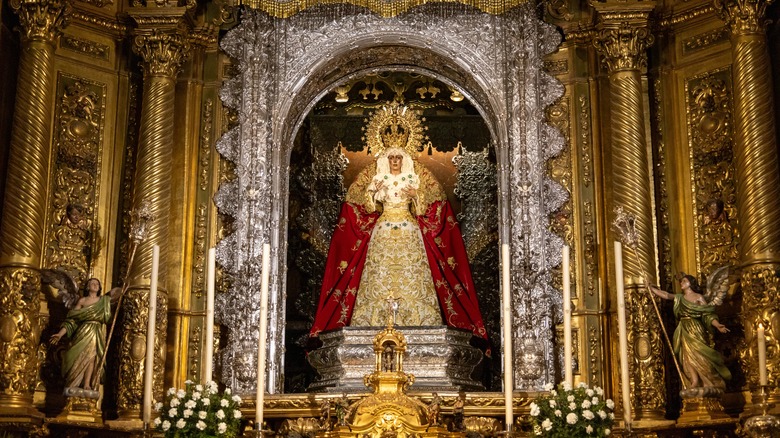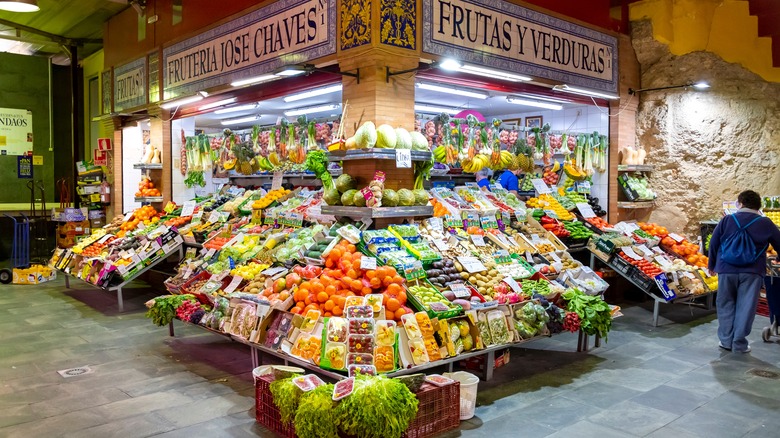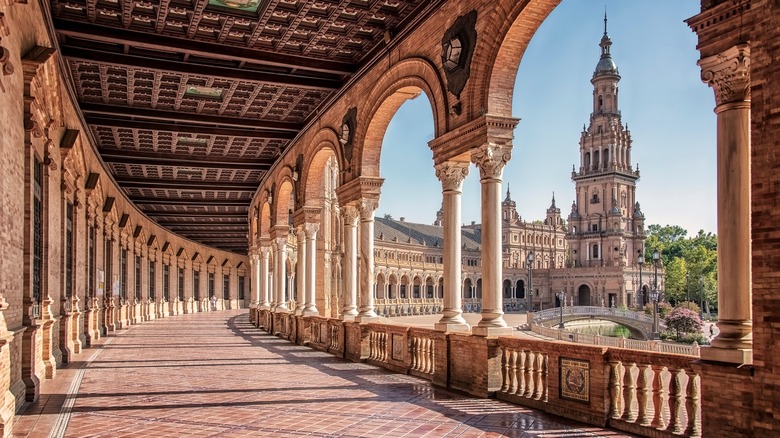Seville, Spain's 10 Best Tourist Attractions Worth Visiting
Seville, the sunny capital of Andalusia in southwestern Spain, boasts endless opportunities for exploring layered histories, unique architecture, and even the largest Gothic building in Europe. The city's streets are lined with more than 25,000 orange trees of a bitter variety that are prized for making marmalade and a local tipple known as vino de naranja, or orange wine. Unique from the other kind of summery orange wine you may have heard of — which is created when grape skins and seeds are fermented with their skins — the variety associated with Seville is made by steeping local white wine from the nearby town of Huelva with bitter orange peels. Better yet, it's just one of the many culinary delicacies you can experience during a visit to this city where tapas reign supreme. And believe us: A cool drink comes in handy in an area that's one of the hottest in Spain. But don't let that deter you!
Seville is home to beautiful squares and numerous museums and churches. The best times to visit, if you want to avoid huge crowds and take advantage of lower rates on lodging, are February or November. December and January are also lovely, but can get very busy around the holidays. If the city's huge, bustling events are what you're after, mark your calendar for Semana Santa — Holy Week — which marks the celebration of Easter. The fabulous Feria de Abril takes over the city two weeks later, during which Seville bursts to life with color, music, dancing, and the most anticipated bullfights. Expansive parks, royal palaces, grand cathedrals, and loads of history await, as do several of the best routes for road trips in Europe. Ready to pack your bags? Here are 10 sights in Seville you won't want to miss.
Catedral de Sevilla and La Giralda
When UNESCO designates something for its sheer size — not to mention its historical and cultural value — it's a pretty good sign that it's huge. The Catedral de Sevilla is composed of five naves and also contains one of the world's largest altarpieces, a gilded masterwork that begun construction in 1482. Work continued in the hands of a handful of artisans until it was finally completed in 1564. The choir, located in the central nave, is an astonishing work of Gothic art, with 117 carved wooden seats that represent saints and biblical scenes. The cathedral is also the final resting place of 15th-century explorer Christopher Columbus. Outside, the iconic Seville fruit trees make an appearance in the beautiful Patio de Los Naranjos, or Patio of Orange Trees.
You have a couple of choices for ways to experience this wonderful ecclesiastical structure. Attend mass in the mornings, where the cathedral is reserved for worship and quiet contemplation. Alternatively, book a self-guided tour during scheduled opening times to see the main cathedral and its famous tower, known as La Giralda. This bell tower began its existence as a 12th-century minaret, originally part of a mosque in the Almohad style. It was then converted to a bell tower for the cathedral in the mid-1200s. Walk up this remarkable structure to take in sweeping views of Seville below. And if you'd like someone to show you around, book a guided tour, which as of writing costs around $25 per person and takes around 90 minutes. A number of themed options are available, including visits to the roof decks, a nighttime tour to see the altarpiece illuminated, and a closer look at the cathedral's stained glass windows.
Real Alcázar
Right next door to the cathedral is the must-see Real Alcázar. Originally constructed in 913 as a fort, it's seen many changes and additions over the centuries, giving it a uniquely layered architectural history. Inside, you'll see astonishing decorative interiors of carved stone and mosaic, and the grand Palacio de Pedro I, or Palacio Mudéjar, represents one of the most beautiful residences in Spain, dating to the 14th century. The Real Alcázar is considered something of Seville's crowning jewel when it comes to style, which is fitting since it's also the oldest royal palace in Europe that's still in use. "Game of Thrones" fans may recognize it as the setting of Dorne from the television series, with beautiful gardens lined with trees and dotted with fountains.
During the high season in Seville, which runs from March to June and September to October, wait times at the entrance can be long. The palace only allows 750 people in the complex at any one time, so if you're sure you want to visit, skip the queue and save the hassle by booking ahead. As of this writing, general admission is roughly $23, with some themed and special tours available for limited runs that are priced accordingly. You can also book VIP tours with Take Walks Sevilla for early access before the palace opens to the public. Better yet, many other private guided tours combine personalized access to both the Real Alcázar and the cathedral. A huge program of flamenco, classical music, world music, and more fills the garden in the evenings during its annual Garden Nights series.
Parque de María Luisa and Plaza de España
About a 10-minute walk south from the Real Alcázar, discover the remarkable Plaza de España. A public square literally built to showcase Seville — and by extension, Spain — for the Ibero-American exhibition of 1929, it was designed in the Spanish Renaissance style and spans more than 650 feet wide. Although a walking or cycling tour is a great way to take in the expansive architectural project, the plaza is also a great place for a wander, since it's free to visit. Take in music and entertainment from street performers and flamenco dancers, enjoy the view from a number of bridges, or hire a rowboat to paddle around in the canal. You may also recognize the setting from iconic films like "Lawrence of Arabia" and "Star Wars: Episode II – Attack of the Clones."
Plaza de España is situated within Parque de María Luisa, which used to be the gardens of the Palacio de San Telmo until they were gifted to the city of Seville in 1893. Here, visitors can take a leisurely stroll along picturesque pathways, grab a seat beneath shady trellises, visit the Archaeological Museum or the Museum of Popular Arts and Customs, and see the buttery yellow Art Deco Mexico Pavilion. If you're worried about dealing with the heat, make sure you bring plenty of water and plan to explore by foot or bicycle. The space is beautiful and completely free to enter, which makes it perfect for spending an entire day relaxing with a picnic and a good book.
Barrio de Santa Cruz
Nestled around the Real Alcázar and Catedral de Sevilla is the charming Barrio de Santa Cruz, a historic neighborhood that was historically the Jewish quarter. This is the tourist locus of Seville, with maze-like, narrow, cobbled streets and alleys, which are perfect for taking photos. There's no shortage of cafes here, with some tucked into the picturesque, orange tree-shaded courtyard of Plaza de Doña Elvira. Other beautiful squares brimming with foliage and history include Plaza de los Refinadores, which sits next to Murillo Gardens, and Plaza de Santa Cruz, with its 17th-century wrought iron cross as its centerpiece. Head to Patio de Banderas, lined with orange trees, where you can take in a great view of La Giralda over the surrounding rooftops. The area's colorful buildings are a fabulous reminder of why Rick Steves refers to this soulful southern city as a "perpetual fiesta."
Barrio de Santa Cruz is a perfect area if you love to wander. It's home to a number of small artisan shops like Arjé Decoracion for home goods and decor, Herbalario Esencias for an amazing selection of tea, and Artesanía Alfaro for ceramic pottery and gifts — plus, of course, plenty of souvenir shops. A wonderful museum not to be missed for architecture- and art-lovers alike is the Hospital de los Venerables, which was originally constructed in the late 1600s as a residence for priests. Often known simply as Los Venerables, the building houses a gorgeous baroque church and works by Spanish painters like Diego Velázquez and Bartolomé Esteban Murillo.
Museo Bellas Artes de Sevilla
After Madrid's renowned Prado Museum, Seville's Museum of Fine Arts may be the country's second most significant. Thanks to its spectacular collection of art spanning the Middle Ages to the 20th century, it's a worthwhile stop on your bucket list of underrated destinations in Spain. Located in El Antiguo Convento de la Merced, or The Old Convent of La Merced, paintings by acclaimed Spanish artists like Diego Velázquez, El Greco, and Alejo Fernández are displayed within beautiful 17th-century surrounds. Look out for some gorgeous, painted ceramic mosaics depicting biblical scenes — like Cristóbal de Augusta's "Virgin of the Rosary" from 1577 — or take in dramatic scenes like Seville-born artist José Villegas Cordero's "The Death of the Master," painted around 1884. Don't forget to look up while wandering around, as the ceilings are also spectacular in their own right.
The Museo Bellas Artes is a remarkable structure unto itself, and its beautiful arched arcades and cloistered courtyards are well worth a peek. The building's origins as a place for religious dedication and seclusion still give it a sense of peaceful refuge, making it a wonderful escape from the city's hustle and bustle today. Right in the front of the building's entrance sits the Plaza de Museo, which as museum-goers will know, is lovely for a relaxing break and staying cool in the shade after soaking in so much art. Grab an espresso or an ice cream cone from Créeme, which is right on the square.
Iglesia Colegial del Divino Salvador
On the site of what may have at once been an ancient Roman basilica, the history of the stunning Iglesia Colegial del Divino Salvador runs deep. It can, for certain, be traced back to at least the ninth century, when it was the home of the Islamic Mosque of Ibn Adabbás. Christians arrived in Seville in the mid-1200s, and the mosque was transformed into a church by transitioning its orientation from north-south to east-west. But it wasn't until the late 1600s that the incredible baroque church we see today began to take shape — after a first attempt ended in disaster when, due to an engineering flaw, the entire structure had to be demolished and reconstructed.
Today, the interior of Iglesia Colegial del Divino Salvador is an elaborate evocation of the sublime, with a richly decorated dome lit by windows, gilded and painted sculptures, and incredible ceramic tile work. It's impossible not to be awed by the nearly 69-foot-tall High Altar, which was created by Cayetano de Acosta between 1770 and 1779. And, of course, looking up is the whole idea, so you won't miss the glorious mural painting above the High Altar by Juan de Espinal.
Real Maestranza de Caballería de Sevilla
While not the largest bullfighting ring in Spain — that distinction goes to Madrid's Las Ventas Bullring — Seville's Real Maestranza de Caballería can hold 13,000 spectators and is one of the nation's most iconic, often referred to as the "Cathedral of Bullfighting." Originally built from wood in 1733, it's one of the oldest round-style rings in the country. That said, even in Spain, bullfighting is a controversial sport. Its reputation as a centuries-old cultural and artistic tradition often butts heads with growing awareness of animal cruelty, since bulls are killed through what many view as a torturous process. And while some municipalities have ceased killing the bulls or banned bullfighting altogether, Seville's tradition continues much as it has since the 18th century. In fact, in Andalucía — a region that Rick Steves describes as being "steeped in the soul of Spain" — bullfighting is still seen as an integral part of their heritage.
Seeing a bullfight at the Real Maestranza de Caballería de Sevilla is an unforgettable experience. The bulls are a special breed raised specifically for fighting, and toreros (bullfighters) use their wits and physicality to lure and move them with the help of vibrant fabric capes. The bullfighting season commences every year on the afternoon of Easter Sunday and runs through early autumn. It's especially popular during the Feria de Abril, when you can experience the crowd exclaiming "Olé!" when a matador is doing well during a fight. Alternatively, if you'd prefer to simply wander through the historic building and its exhibition hall, entry is around $8 for adults.
Basílica de Santa María de la Esperanza Macarena
When we think of basilicas, we often imagine palatial structures with soaring ceilings and incredible naves — two elements which often make them some of the most breathtaking churches across Europe. Seville's Basílica de Santa María de la Esperanza Macarena is a bit of an exception when it comes to size. It's considered a "minor basilica," with a barrel-vaulted single nave and an exterior that belies what sits inside: a rich array of art and ornamentation. While you might be expecting an older structure, this church was actually built fewer than 100 years ago, and consecrated in 1966.
Stunning murals cover the ceiling, and its central icon is the weeping statue of the Virgin Mary, also known as "The Lady of Seville." A symbol of the city, she also happens to be the patron saint of bullfighters. During major Catholic processions, the statue is transferred to an elaborate litter and carried through the streets. Sitting on the northern side of Seville's city center, the best way to visit is to grab a taxi and walk back down toward the city on foot. The route will take you through charming, narrow streets that wind their way through some of Seville's most picturesque neighborhoods.
Metropol Parasol (Las Setas de Sevilla)
In a city brimming with centuries upon centuries of art and architecture, one of the newest structures to grace the skyline is Metropol Parasol. Designed by German architect Jürgen Mayer, the structure opened in 2011 and offers some of the most beautiful views of Seville from what also clocks in as the largest wooden structure in the world. Fondly known as Las Setas de Sevilla — or the mushrooms of Seville, because its form resembles half a dozen toadstools — the contemporary building consists of a series of undulating latticed features. At the top is a walkway that can be accessed for amazing views and photo ops from 85 feet above the ground. Be prepared for it to be busy, though. That said, while the crowds can feel a bit intense at times, the real magic happens after dark, during which the nighttime views of the city are spectacular.
Deep below Metropol Parasol is a subterranean archaeological museum known as the Antiquarium, which highlights ancient Roman mosaics and remnants of a community that was located here in the first century A.D., on top of which Moorish homes were built. It costs just over $2 to visit, but requires a separate ticket from the experience on the walkways above, which costs $19 (some discounts are available for families and groups). On ground level, you'll find a series of eateries and bars. Head to Cervecería La Sureña for authentic southern tapas, or pop into the Mercado de la Encarnación for fresh foods.
Mercado de Triana
Europe is famous for its enormous array of culinary traditions, and it's home to some of the absolute best food markets. Spain boasts some of the continent's largest — like the Mercat Central in Valencia and La Ribera Market in Bilbao, which the Guinness Book of World Records actually pronounced the largest in the world in 1990. As it turns out, Seville also has its own food market that's well worth checking out: Mercado de Triana. Here, you can browse fishmonger stalls, bakeries, butchers, purveyors of fruit and vegetables, and a variety of cheeses and cured pork delicacies. Not only is it a great place to grab a snack or source regional ingredients for a traditional dish, it's also a wonderfully aesthetic experience, with booths stocked floor-to-ceiling with colorful produce, sausages, fresh-caught seafood, and more. Don't miss the opportunity to grab a glass of champagne to enjoy alongside freshly shucked oysters.
There's no better way to experience Spanish cuisine than to cook it yourself with the help of a bona fide chef, and Taller Andaluz de Cocina offers just that. A hands-on cooking class that includes a guided tour of Mercado de Triana, you'll learn expert tricks of the trade before assisting in the preparation of a three-course meal. Better yet, you'll get to sample delicious Spanish olives, sip sangria, and of course, enjoy your carefully crafted dishes once you've finished.
Methodology
Seville is chock full of historic, picturesque, and fascinating sites that range from contemporary tourist attractions to baroque architectural marvels. To share some of the best, especially those that are worth visiting during your first trip to the city, we consulted regional tourism websites like SevilleCityGuide.com, VisitaSevilla.es, WelcometoSeville.com, and Seville-Traveller.com. We also researched specific information about prices, visiting hours, experiences, and unique collections on specific attractions' websites, including SetasdeSevilla.com, MuseosdeAnalucia.es, HermandaddelaMacarena.es, TallerAndaluzdeCocina.com, MercadodeTrianaSevilla.com, and more. For factual information regarding historical sites, we referenced Andalucia.org and UNESCO. Finally, we also relied on the author's personal experiences in Spain, plus visitor reviews and ratings shared on TripAdvisor and Civitatis.com.
